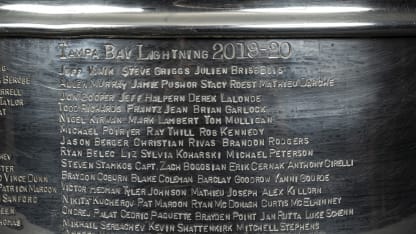As Tampa Bay Lightning goaltender Andrei Vasilevskiy and his family -- including his mother and father who flew in from Russia -- pulled away from a dock in downtown Tampa on a yacht owned by his agent Dan Milstein for his day with the Stanley Cup, Vasilevskiy's father, Andrei Sr., sat privately on the top deck with the Cup in front of him and studied the names on the 37-pound memorial to hockey greatness for close to an hour in silence.
There was plenty to take in.
How the 2019-20 Tampa Bay Lightning were engraved on the Stanley Cup
It took over nine days for Louise St. Jacques to stamp the names of 52 Lightning players and staff into hockey history forever

© SCOTT AUDETTE
The name of Basil Pocklington, father of Edmonton Oilers owner Peter Pocklington, had been X'd out under the 1983-84 Oilers. The younger Pocklington tried to slip his dad's name in among those submitted to be on the Stanley Cup despite no affiliation to the Oilers other than fathering the team's owner. Once the National Hockey League found out - after the name had already been stamped on the Cup - they crossed out the elder Pocklington's name with 16 X's.
The 1971-72 Boston Bruins didn't win the Stanley Cup. Apparently, a new team named the Bqstqn Bruins were champions that year, at least according to the engraving on the Cup.
Henri Richard's name appears 11 times on the Stanley Cup, the most by any player, followed closely by fellow Montreal Canadiens Jean Beliveau and Yvan Cournoyer, who are on it 10 times.
There are 17 women on the Stanley Cup, including Tampa Bay's own Liz Sylvia Koharski, the Lightning's director of hockey administration.
But the name the elder Vasilevskiy was most interested in was the one he helped to create.
On the bottom ring of the Cup was the newest member of hockey's exclusive club, the 2019-20 Tampa Bay Lightning, the third team to be permanently stamped on the lowest ring right beside the 2017-18 Washington Capitals and 2018-19 St. Louis Blues.
And of the 52 names the Lightning submitted to go on the Cup, all the way at the bottom on the left-hand side was the one he was most interested in: his son, Andrei Vasilevskiy.

He looked at the Vasilevskiy name for quite a while, rubbed his thumb over it at times to make sure it was real, took copious photos.
It was a scene that would not have happened but for COVID-19.
Because the NHL season paused in March and resumed in August, the Lightning eventually winning the Stanley Cup in late September, the decision was made to engrave the names of the new champions on the Cup before Lightning players, coaches and staff got their day with it. Typically, names don't go on the Stanley Cup until the next season's training camp. In a normal offseason, players would have their day with the Cup without seeing their name on it.
Sometimes, players don't see their name on the Cup until well after they've won it. Former Lightning defenseman Jassen Cullimore said it was six years before he saw his name on the trophy. His daughter pointed it out to him while he was in a Stanley Cup championship parade with the Chicago Blackhawks in 2010, well after he won the Cup with the Lightning in 2004. His signing as a free agent with Chicago in the summer of 2004 along with the NHL lockout the following season meant Cullimore never came in close proximity to the Cup again until it happened to be sitting on the floor of his double decker bus in front of him during the Blackhawks' championship parade.
The 2019-20 Tampa Bay Lightning won't have to wait anywhere close to that long to see their names. While the League, the Lightning and the Hockey Hall of Fame were figuring out how the Bolts would get their days with the Cups with Covid restrictions in place in the days following the Bolts six-game victory over the Dallas Stars in the Stanley Cup final, the Cup was sent to Montreal to be engraved by Louise St. Jacques, who began engraving the Cup in 1982 and is one of only four official engravers of the Stanley Cup throughout its history.
When it came back to Tampa, the newly-added names afforded players and their families the chance to see the permanence of what they had just accomplished.
"In this world where we've got difficult times right now, getting the Cup engraved early on was kind of a pleasant surprise and a bonus," said Phil Pritchard, the original Keeper of the Stanley Cup. "I've been doing this 32 years, and the Cup has never been engraved before training camp. Usually when the guys spend some time with it, their names aren't on it. So they get that opportunity to see it usually right around Opening Night, and, for some, they're traded or retired or moved on or whatever so they don't see it. And what's so special about seeing your name is it's the family name. It's not their hockey name, it's their family name now. They've got their hockey name Tampa Bay Lightning on it, but now they've got their family name on it too. It's one thing to win the Cup but another to see your name actually on there and to know it's going to be on there forever and you're part of that Stanley Cup union forever."
---
Louise St. Jacques has been the Stanley Cup's official engraver for 38 years now.
"It may be 38 years, but it seems like yesterday," she said.
Working from her studio at Boffey Promotions on Rue Saint-Francois-Xavier in the Ville-Marie section of Montreal, St. Jacques takes ownership of the Stanley Cup for about 10 days every offseason to add the names of the newest champions.
St. Jacques receives a list of names - 52 is the maximum allowed, although the 1997-98 Detroit Red Wings have 55 names on the Cup, the most of any team -- submitted by the championship team and approved by the NHL. She then gets to work calculating how to stamp several hundred letters, arranged correctly, in a pre-defined space.
"The set-up time varies usually taking five days to plan and execute the stamping," St. Jacques said via email.
When St. Jacques receives the Stanley Cup, she disassembles it, taking all five rings off. The current bottom ring is placed on a shaped steel form ready for stamping (while engraving is the verb most often used, the process for adding names to the Stanley Cup is by stamping). Her tools are a weighted hammer and three different sets of metal letter punches, including upper and lower case letters.
"The letters are hammered in following a secured metal guide to keep lines straight, but is ultimately a free hand process," St. Jacques said.
St. Jacques estimates it requires 10 hours total to stamp the names. She works in 90-minute intervals. Each name takes about 30 minutes. It's tedious, meticulous work. Each letter is struck with the weighted hammer by hand.

Every 13 years, the bottom band of the Stanley Cup is filled and a new blank band is then added, the top band coming off the Cup to be retired to the Hockey Hall of Fame in Toronto and all the other bands moving up a rung. The last new band was added in 2018 when the Washington Capitals won their first Stanley Cup.
There are three removed bands currently on display at the Hall of Fame. The last band to come off features 12 championship teams from the 1953-54 Detroit Red Wings through the 1964-65 Montreal Canadiens.
St. Jacques works in silence and avoids interruptions during the stamping process, which can be nerve-racking, particularly when a mistake can become a permanent part of hockey history.
In 1996, the Colorado Avalanche's Adam Deadmarsh had his name misspelled Adam Deadmarch. It was later corrected, a first for the Stanley Cup.
"This historic Cup is not very forgiving for mistakes whether short or long," St. Jacques said. "The Stanley Cup is a very high-profile trophy and nerves play into any work done on this ultimate sports achievement."
It took St. Jacques nine full days and a few hours to stamp the names of the 2019-20 Tampa Bay Lightning into the Stanley Cup. Covid affected the time of year the stamping took place, this time occurring in late October rather than the typical mid- to late-September. The pandemic also made it impossible for Pritchard to bring the cup to St. Jacques in Montreal as he usually does.
In a traditional offseason, Pritchard would hand deliver the Stanley Cup himself to St. Jacques at her Montreal workspace. Typically, Pritchard said, they'd try to finish days with the Cup with Quebec players and then leave the Cup in Montreal.
But because of partial lockdowns in parts of Quebec, Pritchard was not allowed to accompany the Cup to Montreal. Instead, he drove the Cup to Toronto's Union Station and boarded it inside a private rail car on a train bound for Montreal.
For a couple of hours, a random VIA Rail employee - VIA Rail is Canada's version of Amtrak - became one of the handful of Keepers of the Cup entrusted with ensuring its safety, guarding the Cup locked inside its protective case for the roughly six-hour train ride until it reached its destination, where St. Jacques was able to take possession.
"It was a neat way how we did it," Pritchard said. "Our hats off to our friends at VIA Rail for supporting us. I guess everybody's a hockey fan. They all want to help out."
The Stanley Cup returned to Toronto nine days later - fresh with the engravings of the 2019-20 champion Tampa Bay Lightning - the same way it left: by train.
"It actually got delayed because I think there were weather problems in Quebec, so it didn't get to Toronto until 11:30 pm. October 31st and our flight back to Tampa was 8 a.m. the next day. By noon on November 1 we were back in Tampa. It was a quick turnaround, but we all worked together, we all thought outside the box and we all got it done."
There are currently 2,394 individuals engraved on the Stanley Cup.
The 2019-20 Tampa Bay Lightning comprise 52 of those names.
"To me, it's one of the best stories in hockey is the engraving of the Cup because your name's going to be associated with the Cup forever," Pritchard said. "You're a Tampa Bay Lightning Stanley Cup champion in 2019-20 and no one can ever take that away from you."


















